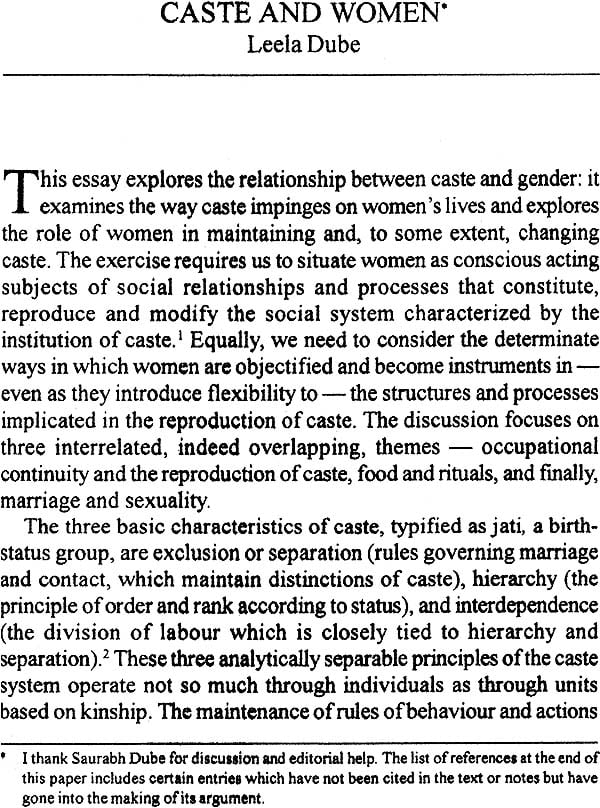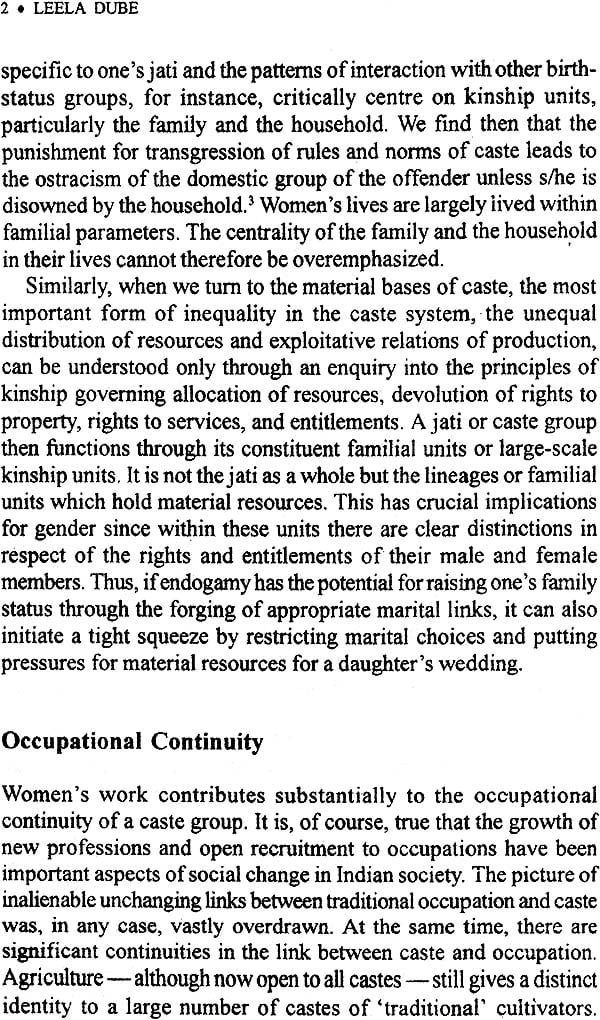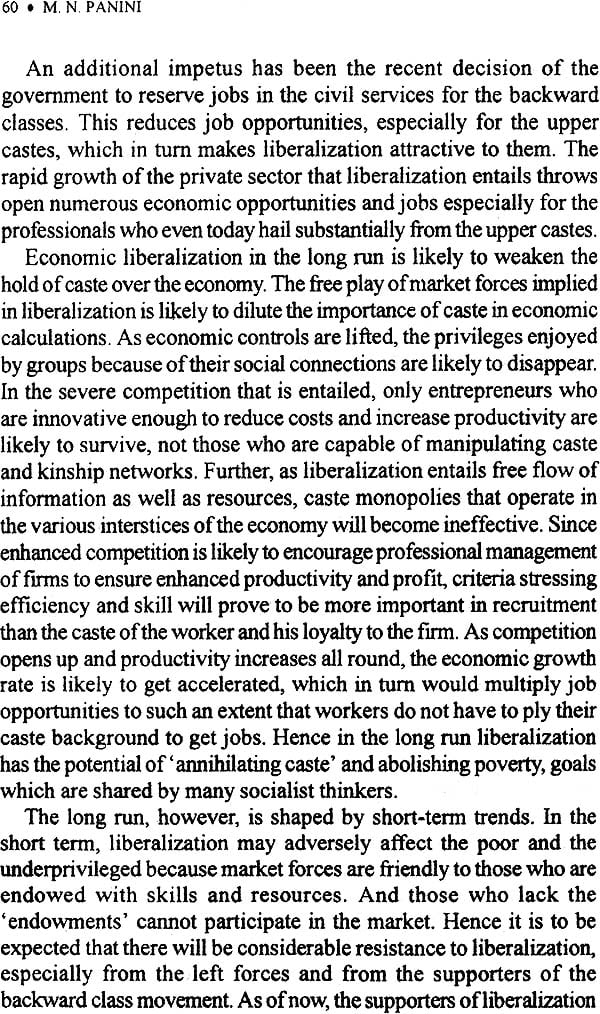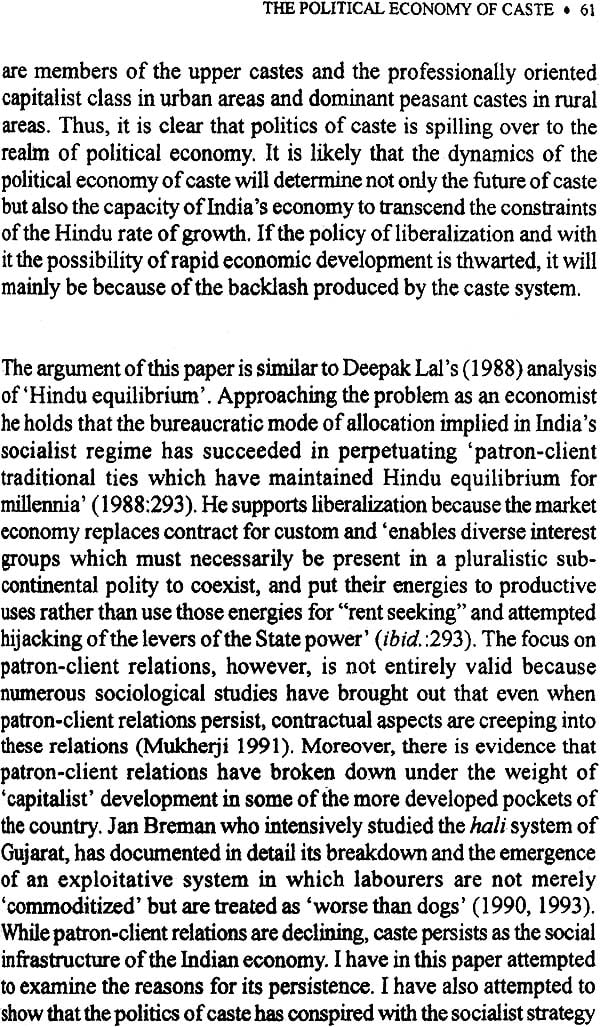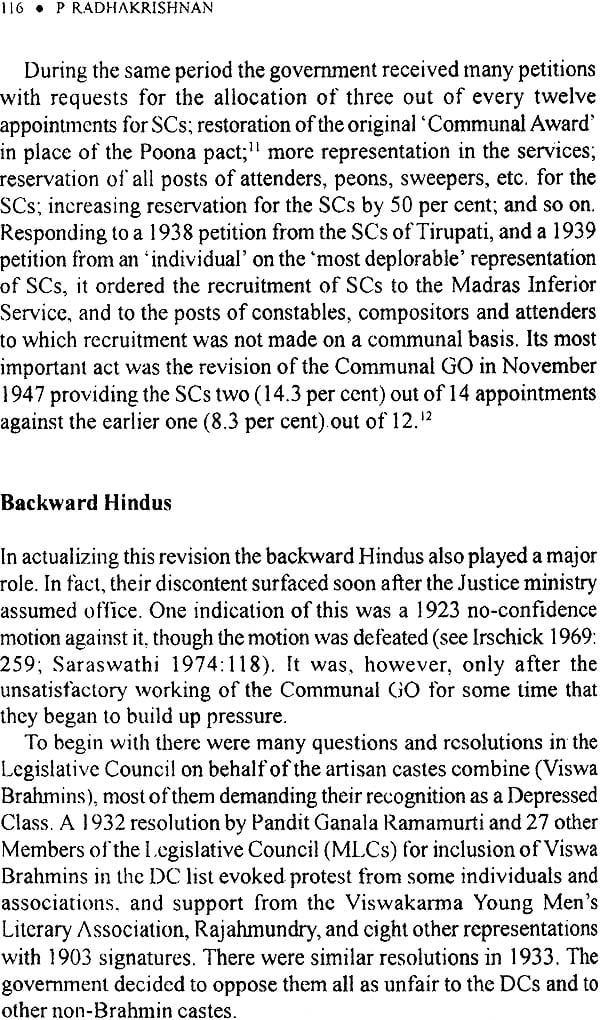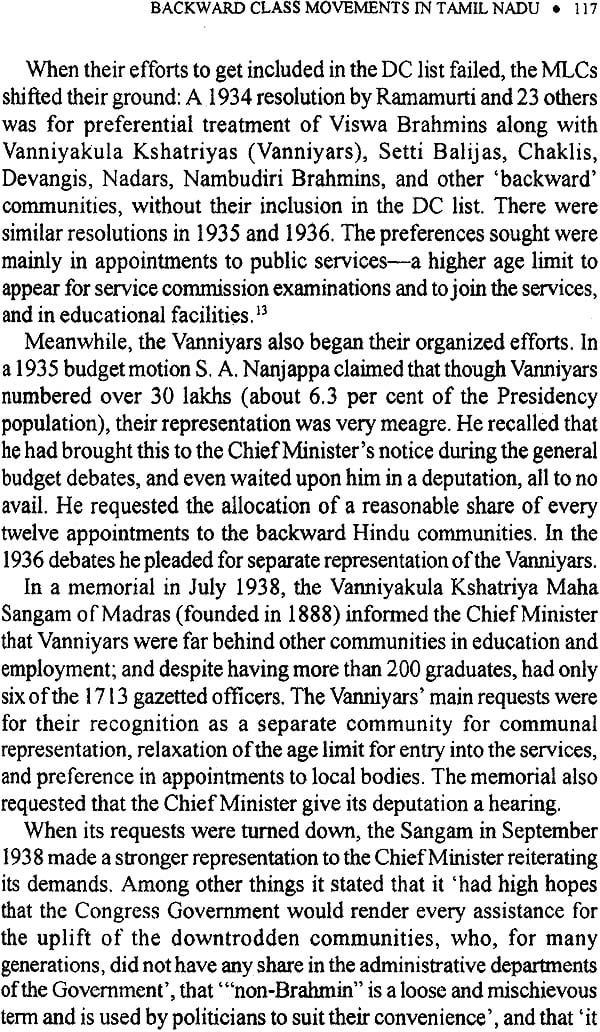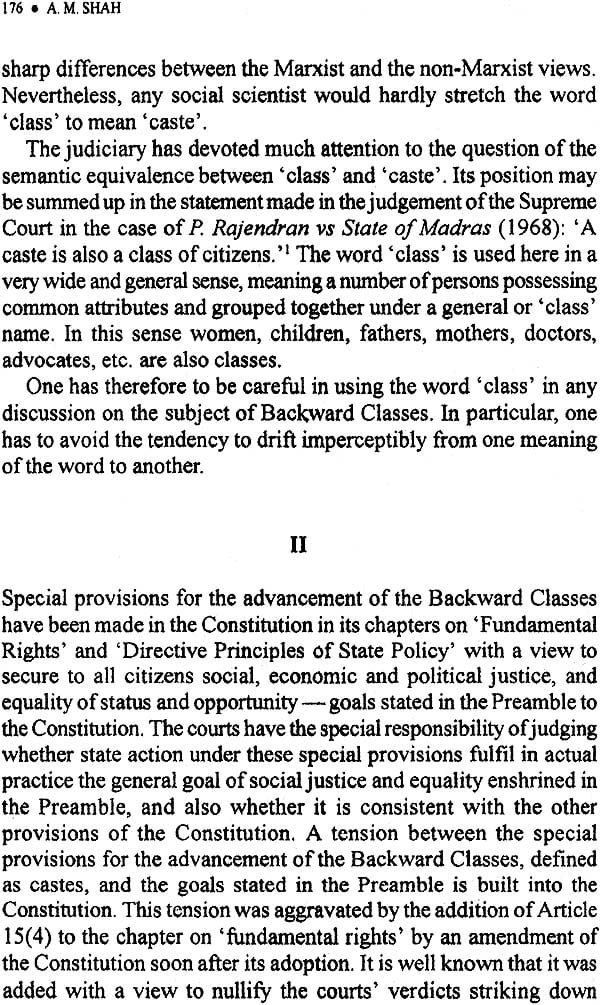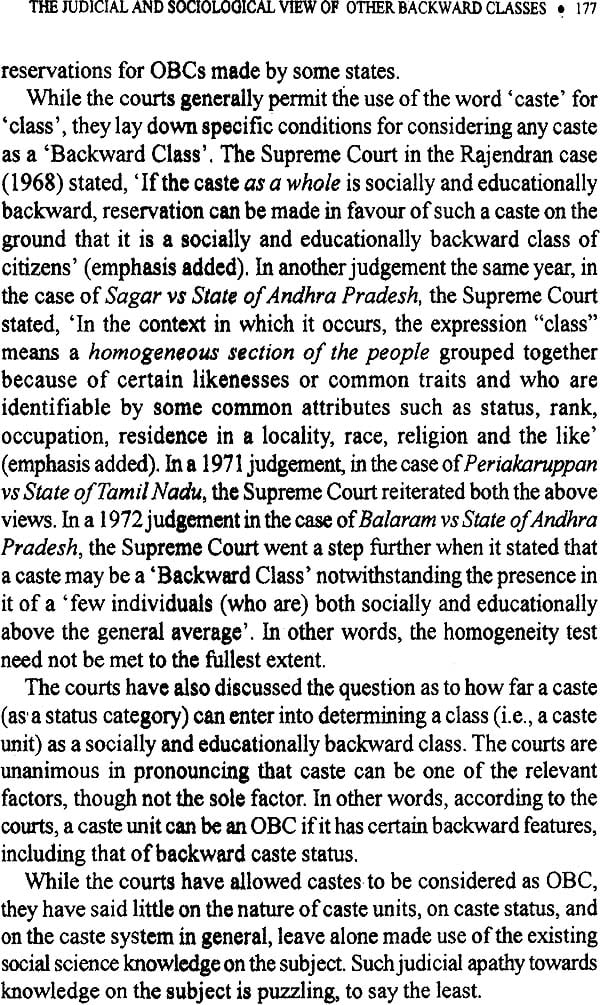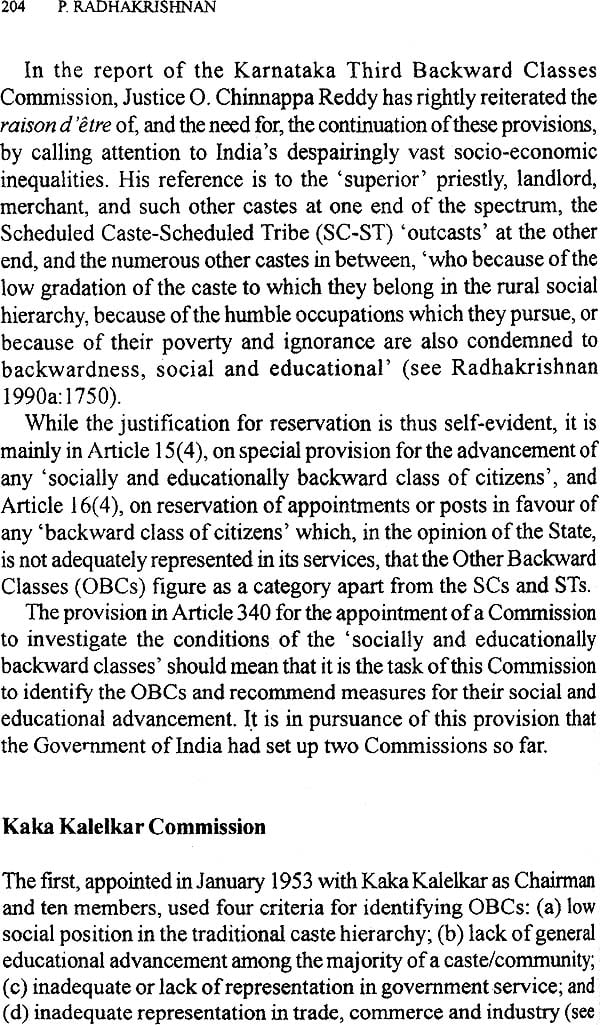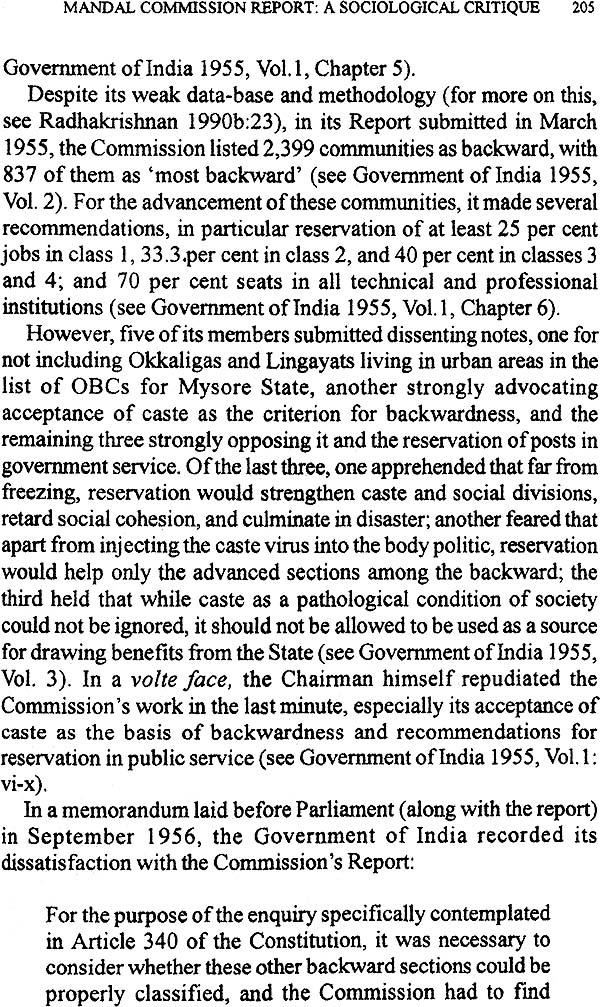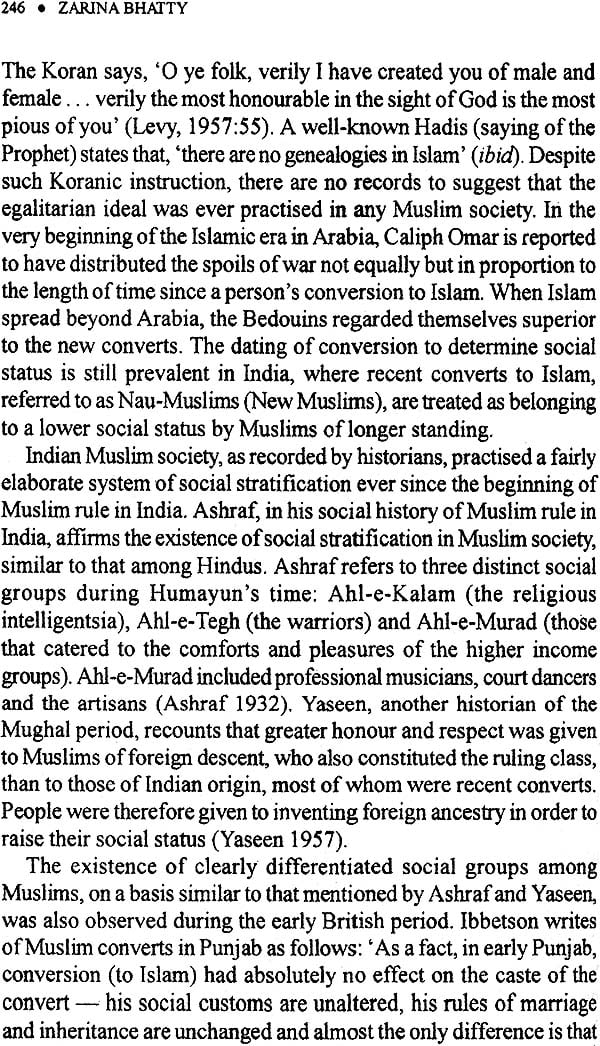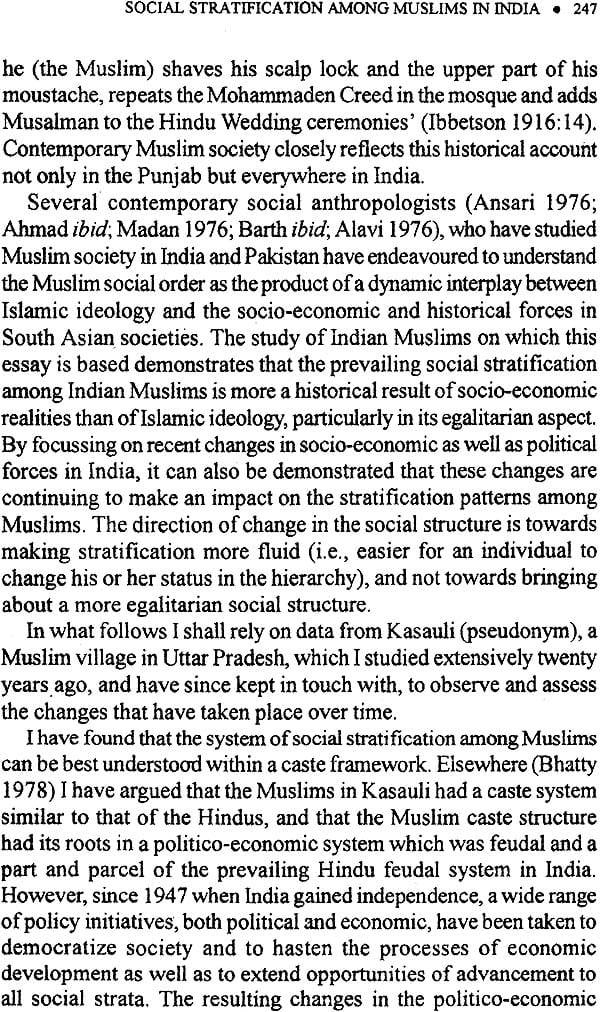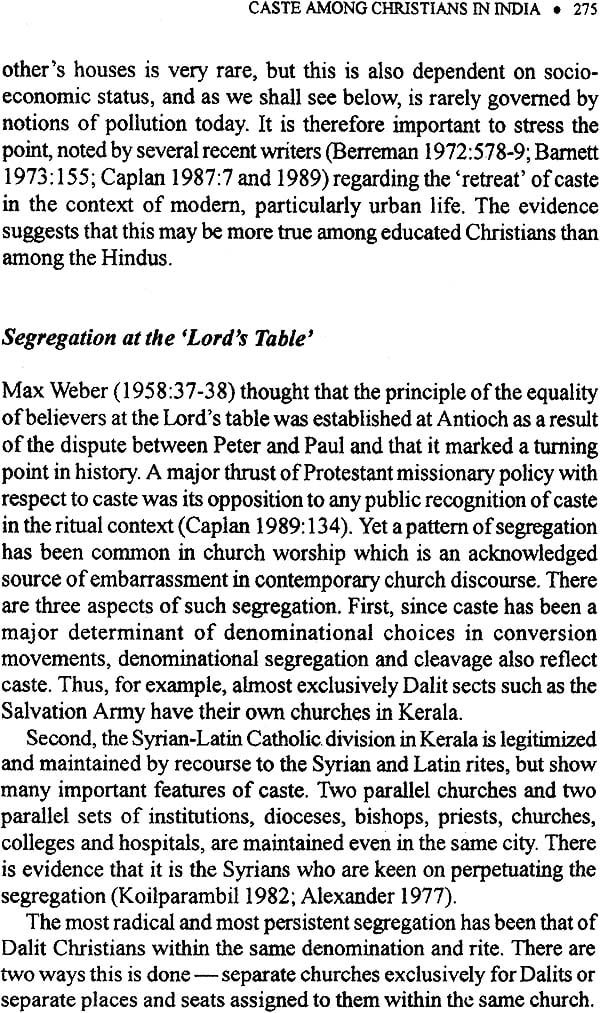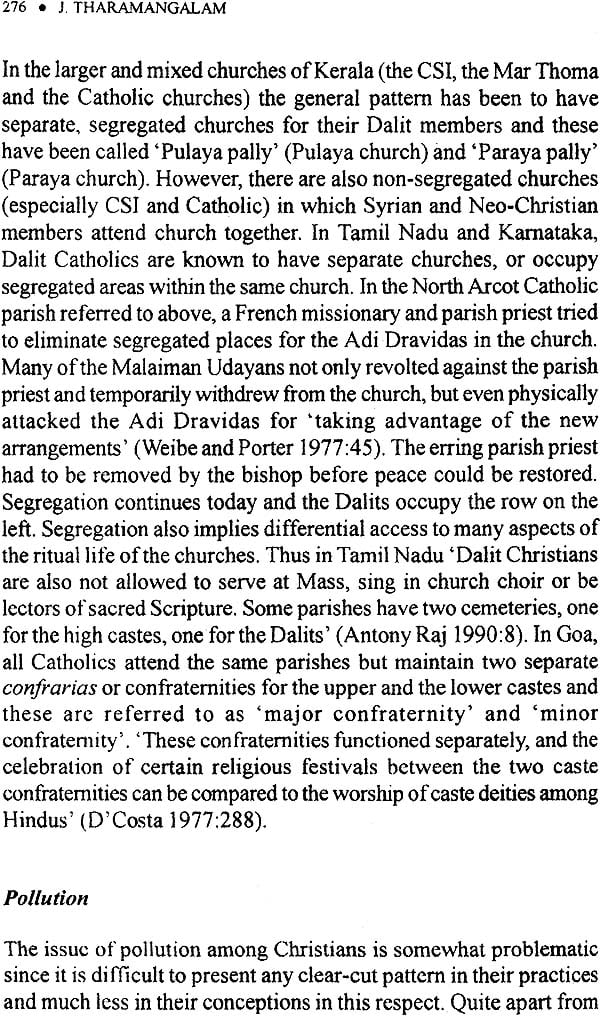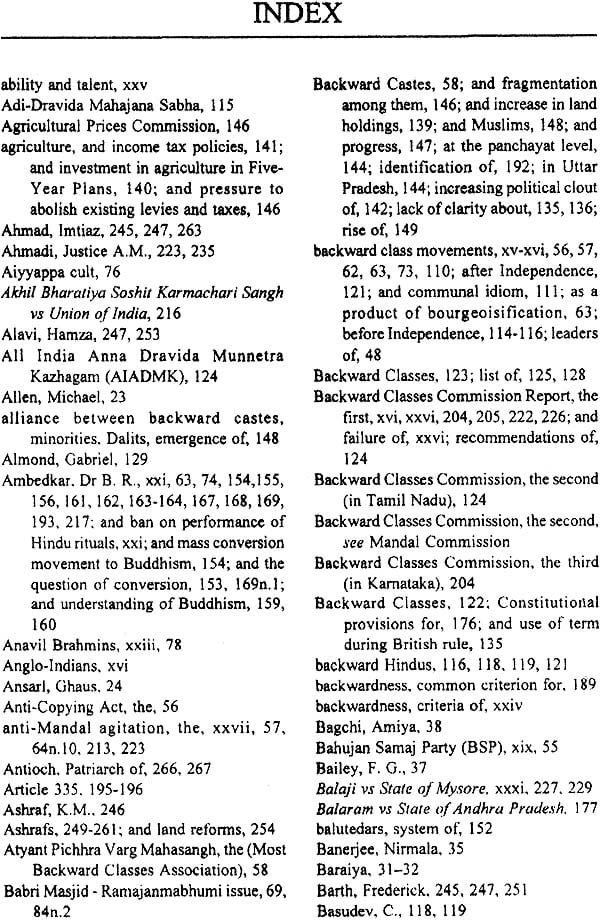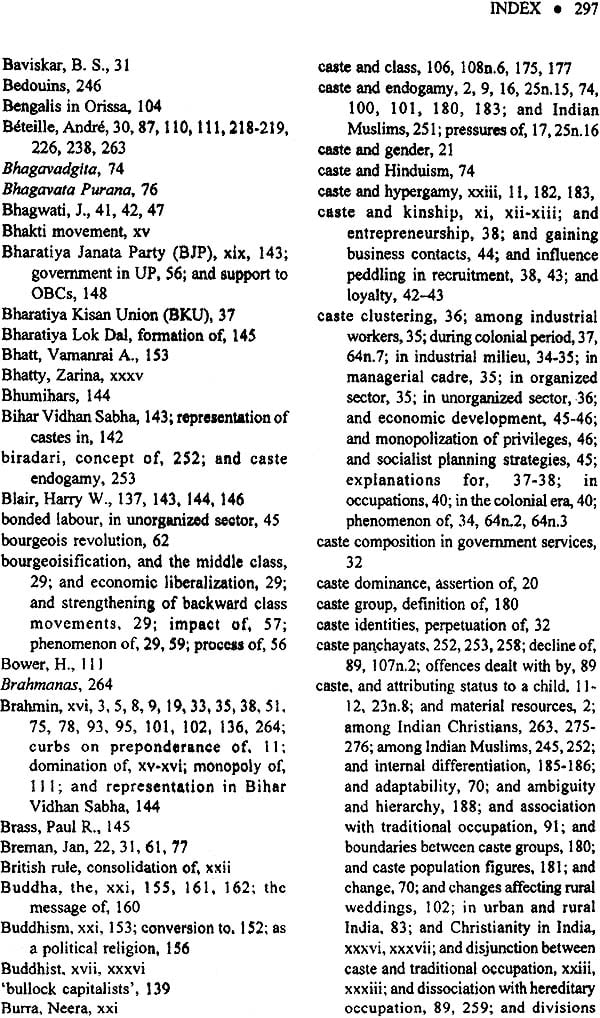CASTE: Its Twentieth Century Avatar
Book Specification
| Item Code: | IDE372 |
| Author: | Edited and Introduced By: M.N. Srinivas |
| Publisher: | Penguin Books India Pvt. Ltd. |
| Language: | English |
| Edition: | 1997 |
| ISBN: | 9780140257601 |
| Pages: | 344 |
| Cover: | Paperback |
| Other Details | 7.8" X 5.2" |
| Weight | 290 gm |
Book Description
From the Jacket:
As India attempts to modernize and ready itself for the twenty-first century, the issue of caste takes on an overwhelming importance. What form does caste take today? How can its debilitating aspects be countered? This book, edited and introduced by one of India's most eminent sociologists, attempts to answer these and other crucial questions.
The essays in this volume, each authored by an expert on the subject, include a stimulating assessment of the role of women in perpetuating caste; incisive analyses of the relationship between caste and the economy, and between caste and Hinduism; a review of the backward class movements in Tamil Nadu; a commentary on the power struggle in UP and Bihar amongst the backward castes; the relationship between efficiency and job reservation; observations on caste amongst Muslims and Christians in India and critiques of the Mandal Commission Report and the Mandal judgement.
About The Author:
Professor M. N. Srinivasa, FBA, the doyen of sociology and social anthropology in India, started his academic career at Oxford where he taught in a department headed by the late professor E. E. Evans Pritchard. He started the first department of sociology in India at MS University, Baroda and later headed the department of sociology in Delhi University. In 1972, he founded the Institute for Social and Economic Change (ISEC) in Bangalore, along with Professor V. K. R. V. Rao. Professor Srinivas was JRD Visiting Professor at the National Institute of Advanced Studies, Bangalore. He died in 1999.
There has been a great deal of writing on caste beginning from the early periods of Indian history, but the writers have invariably been men. It is only in recent years that women scholars such as the late Irawati Karve and Professor Pauline Kolenda, to mention but two, have written on the subject. Valuable as these writings are, they do not look at the institution from the point of view of women. I thought that it was time that this deficiency was rectified, and I am glad that Professor Leela Dube responded to my request. Her essay 'Caste and Women' meets this need. It has been placed at the head of this volume in order to emphasize the need for looking at the hoary institution of caste from the point of view of women.
Each essay in this collection represents a contribution to the understanding of one or more aspects of caste by a specialist. Caste can no longer be treated as a subject of interest only to social scientists and the media. Policies regarding the quantum and details of reservation are matters of great interest to the people at large, politicians and officials.
Much has been written on the link between caste and occupation but here again, as in other areas, the emphasis has been on the male dimension. The occupational contribution of women has generally received only cursory treatment when it has not been totally ignored.
Since the 1950s, the concepts of purity and impurity have been seen as central to caste not only in indicating the rank of a jati in the local hierarchy but also in several other areas. Women are more directly concerned with purity-impurity than men, and the kitchen may be described as the heart of the purity-impurity system. (Remember Vivekananda's condemnation of folk Hinduism as a religion of the kitchen') It is women who have to prepare and serve the food, and among many castes they have to be ritually pure while handling food. The rank of a caste depends on the avoidance of some impure foods (and liquor). Food is an important part of domestic ritual - daily, life-cycle and calendrical - and the ritual varies according to caste and domestic traditions. Women are expected to know the special foods that need to be prepared for each important ritual, and women are the de facto custodians of tradition.
Punishment for the violation of the rules of purity-impurity in matters of food and sex operate far more harshly against women than on men. As Leela Dube puts it, 'Sexual asymmetry (between men and women) is bound up with the maintenance of the hierarchies of caste.' Also, 'Caste is not dead. Gender is a live issue. The principles of caste inform the nature of sexual asymmetry in Hindu society, and hierarchies of caste are articulated by gender.'
Recent research has proved abundantly that caste in pre-British India was not a totally rigid institution. It was possible for strategically located groups to move up in the local hierarchy through the capture of political power, the acquisition of land, through trade, and through migration to other regions. But such mobility always resulted in the loss of 'freedom' for women. High status, whether acquired through caste, or the ownership of wealth, meant that women were confined to the home and subjected to a harsh sex code. Pre- and extra-marital sex led to the loss of caste for women of the higher castes, and widowhood implied a life of perpetual mourning. In extreme cases, she committed sati.
While the part played by caste in politics, especially in the context of elections, agitations for enhanced reservation of seats in higher education or government jobs for backward classes, and the inclusion or omission of particular castes in the Other Backward Classes (OBC) or Scheduled Castes (SC) list, have been commented upon by scholars and journalists, the study of the relation between caste and the economy has not received adequate attention. Professor Panini explores this important relationship in his essay, 'The Political Economy of Caste'.
In the complex political economy of modem India, caste continues to provide a support base for members, a fact which is particularly important for upwardly mobile villagers who seek salaried jobs in the urban bureaucracy, industries, firms and offices. The articulation of kin, caste and patron-client ties are crucial to spatial and social mobility. In the words of Panini, ‘... the membership of a caste implies that a person becomes part of a person-based social network which controls insiders' information about economic opportunities, transmits skills, and provides varied types of human and material support.' This particular role of caste has been steadily gaining importance in the last 150 years or more, with new economic opportunities becoming available in India and abroad. In the context of developments in the country since Independence, Panini points out that the regime of economic control (intrinsic to socialism and centralized planning) has contributed to the strengthening of caste ties by encouraging, albeit indirectly, the growth of the unorganized sector.
Socialism, central planning. a vast public sector both at the centre and in the states, a state-controlled educational system etc., have facilitated the pursuit of an employment policy in which political considerations have played an important part, with efficiency becoming a secondary issue if not a casualty. Thanks to the policy of protective discrimination the weaker sections of the population have developed vital stakes in state-controlled economy, and they are also aware of the clout they wield over politicians. But the new political and economic winds favour a reduced role for the state in economic matters: 'Hence the hard-won battle for backward classes' reservation will prove meaningless if the government retreats from the commanding heights of the economy, and if it sheds many of the regulatory and control functions. Such steps would not only reduce the number of posts in the government but diminish the authority vested in government jobs.'
Until recently, the 'central services', in particular, the prestigious Indian Administrative Service (lAS) and the Indian Police Service (IPS), were attracting some of the ablest graduates in the country. But with liberalization and privatization, it seems likely that government and public sector jobs will become less attractive. This will not happen only because of wide disparities in salaries. As of now, 50 per cent of jobs in the Union Government and Central Public Sector Undertakings (PSUs) are reserved for the weaker sections, and there are moves to increase the reservation to 62 per cent or more. In the southern states, particularly Tamil Nadu and Karnataka, reservation reaches 70 per cent or more. And only the very rich can buy seats for their offspring in the 'capitation fee' institutions. As a result, the more informed among the middle classes are sending their offspring to institutions abroad even for an undergraduate degree, and no one seems to be concerned at the brain drain that this means for the country.
Panini mentions the possibility of a 'backlash from the caste system' putting an end to liberalization. This is not unlikely in spite of the occasional brave statements from spokesmen for the Central Government that the 'reforms are irreversible.' A call to put an end to the present less-than-wholehearted liberalization might attract support from a few political parties and vested interests. This is particularly likely when general elections are only a few months away. The only positive sign is that chief ministers of all political hues are going abroad to attract foreign capital and expertise. In the process, they have conjured up visions of prosperity for their respective states, which have reached the people, the voters. Chief ministers have also grasped the fact that liberalization implies more decentralization and more power to their elbows.
In 'Caste and Hinduism', Dr Jayaram makes the point that castes may be viewed either as .... functionally interrelated in a system contributing to the vertical integration of a rigidly stratified society, or as autonomous groups serving common purposes and striving for common ends. Viewed as the former, caste constitutes a structural principle of society and viewed as the latter, it acts as a dynamic force in interest articulation, collective mobilization and social movement. While changes in the institution of caste can be comprehended fairly easily from either of these analytical perspectives, the relationship between the realities subsumed by them is complex and eludes analytical grasp.' However, there is no doubt that the two systems are linked in a variety of ways. For instance, upwardly mobile villagers need the help of their fellow-castemen (and fellow villagers in towns) to obtain access to urban facilities and resources, while the urban dweller might need village contacts to provide him with servants, help him secure a bride for his son, and to expand his business or trade. And if he has political ambitions, he needs to keep in close contact with his rural base. Further, caste organizations depend heavily on the cooperation of villagers when they need to put pressure on politicians and the government to extract favours from the latter.
There are differences between rural and urban castes but the members of the same caste living in a region come together on occasions of common concern. A caste is an elastic body, the group being smaller for endogamy than, for instance, for pressing its right to claim backward class status. 1 have earlier referred to this phenomenon as the 'horizontal stretch' of castes, and while this is most visible in the case of 'dominant castes', it is seen in other castes also. Commenting on the government's goal of bringing about a 'casteless and classless society', Jayaram comments tersely, 'Caste is not being abolished - at least in the short run - but made to stand on its head.' The political rhetoric of modern India ignores the fact that large numbers of people born into the higher castes are poor and backward and they resent the fact that members of the OBCs enjoy concessions and benefits which are denied to them. Even more noticeably, there is widespread resentment of the Scheduled Castes (SCs) and Scheduled Tribes (STs) over the concessions and benefits they enjoy and it is likely to rise as the Dalits become more militant. Envy of the Dalits is particularly high among the castes just above the pollution line.
Jayaram has remarked that' ... one can argue that castes and the caste system can survive the purity-impurity ideology, and the institution of caste can even survive Hinduism.' But before discussing Jayaram's prediction regarding the future, it must be made clear that Hinduism is not in any danger of disappearing. Far from it, Hinduism seems to be thriving and getting increasingly involved in politics and social work. A few social scientists have stated that the character of Hinduism is changing, that it is becoming ‘semiticized’ as a result of its contact with various forces- religious, political and culture- in the modern world . However, this issue does not concern us here.
| Acknowledgements | vii |
| Introduction M. N. Srinivas | ix |
| Caste and Women Leela Dube | 1 |
| The Political Economy of Caste | 28 |
| Caste and Hinduism: Changing Protean Relationship N. Jayaram | 69 |
| Caste in Contemporary Rural India G. K. Karanth | 87 |
| Backward Class Movement in Tamil Nadu P. Radhakrishnan | 110 |
| Backward Castes and Social Change in UP and Bihar and Women Meenakshi Jain | 135 |
| Buddhism, Conversion and Identity: A Case Study of Village Mahars Neera Burra | 152 |
| The Judicial and Sociological View of Other Backward Class A. M. Shah | 174 |
| Job Reservation and Efficiency A. M. Shah | 195 |
| Mandal Commission Report: A Sociological Critique P. Radhakrishnan | 203 |
| The Mandal Judgement: A Brief Description and Critique B. Sivaramayya | 221 |
| Social Stratification Among Muslims in India Zarina Bhatty | 244 |
| Caste Among Christians in India J. Tharamangalam | 263 |
| Notes on the Contributors | 292 |
| Index | 296 |
